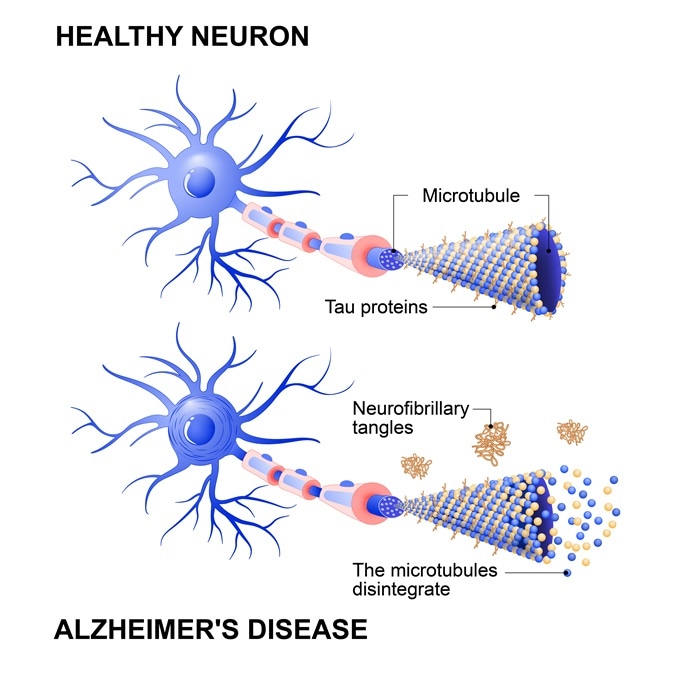Scientists from the Britain's Medical Research Council Laboratory of Molecular Biology have for the first time, clearly pictured what the deposits typically seen in a person with Alzheimer’s disease look like. This is a breakthrough in neurodegenerative diseases. The latest study showing the structure of tau protein was published in the journal Nature.

Alzheimer's disease is the change in tau protein that results in the breakdown of microtubules in brain cells. Mechanism of disease. two neurons: healthy cell and neuron with Alzheimers. Tau hypothesi. Image Credit: Designua / Shutterstock
For this effort the researchers looked at the brain tissues of a 74-year-old woman who had died. She was suffering from Alzheimer's disease. Alzheimer’s disease typically means progressive dementia or loss of memory and brain functions. It has been seen earlier that brains of individuals who study from this condition develop tangles of a protein called tau. These tangles or knots of protein spread throughout the brain. As they grow in numbers, they tend to worsen the symptoms. Tau tangles have been known to scientists and the medical fraternity for decades now. What was not known was how these tangles actually look like.
As a first, this team of researchers took detailed images of the tau inside the patient’s brain tissues. Using computer software they recreated how the tangles might look microscopically. While a picture of these proteins could not be something especially interesting or fascinating to most people, scientists believe that a detailed knowledge of how it looks to help develop drugs to control their growth. If the chemical structure of what is to be targeted is known clearly, it is but natural that drugs could be developed to fight it. According to Dr Sjors Scheres, one of the researchers, drugs aimed at the disease protein till date was akin to “shooting in the dark”. Now researchers have provided a concrete structure against which the weapons could be used more definitively. Why this study opens a “new era” in neurodegenerative disorders is clear. Other brain proteins that cause these diseases such as beta amyloid protein deposits in Alzheimer’s disease or alpha synuclein in Parkinson’s disease, can now all be clearly photographed and better understood explained researchers.
According to co researchers Dr Michel Goedert this was the first time a high resolution structure from human brain tissue was determined for these debilitating diseases. Not only drug development in these diseases, it could also help us understand the disease more clearly.
For this study the lab used a technique known as cryo-electron microscopy at 3.4–3.5 Å resolution. They mapped the finer details of the structure of the tau protein. In Alzheimer’s disease there are two types of abnormal proteins or neurofibrillary lesions as they are termed, in the brain. While tau filaments are formed within the nerve cells of the brain, beta amyloid proteins are formed outside the nerve cells in the form of filaments. Tau proteins in normal brains can help in nerve function. But among patients with Alzheimer’s they tend to get into clumps and tangles within the nerve cells. The images show that the filament cores of the tau protein are made up of two identical protofilaments that have residues 306–378 of tau protein. These form a cross-β/β-helix structure or coils around each other much like the DNA strands do.
Researcher Sjors Scheres said that this study can help show which parts of the filament formation of these tau proteins are actually important in the development of the disease and eventually could be drug targets.